Abstract
This paper presents an experimental study of the system identification and vibration control of a cantilever beam. For system identification, a white noise was applied, and the response signal was measured. These signals were used to feed the eigensystem realization algorithm–Observer/Kalman Filter identification method. The identified system was reduced using the Hankel norm model. An linear quadratic regulator controller was projected to operate just on the first two natural frequencies of the structure. The damping ratio of the first mode was effectively increased from 0.009 to 0.046.


















Similar content being viewed by others
References
Alves, M. T. S. (2005). Avaliação numérica e experimental dos métodos ERA e ERA/OKID para a identificação de sistemas mecânicos. Dissertation of Master’s Degree, UFU-MG, School of Mechanical Engineering, Uberlândia.
Alves, M. T. S., & Ribeiro, J. F. (2004). Identificação de Sistemas Mecânicos Lineares usando o ERA (eigensystem realization algorithm). Belém, PA: III Congresso Nacional de Engenharia Mecânica.
Bernal, D., Gunes, B. (2000). Performance of an observer state-space identification in the presence of mild nonlinearities. In Proc. 2000 American control conference, Chicago, IL.
Deistler, M. (2004). System identification–general aspects and structure, interuniversity attraction poles-phase V-dynamical systems and control: Computation, identification and modelling. Louvain-la-Neuve.
Dorf, R. C., & Bishop, R. H. (2001). Sistemas de controle modernos. Tradução Bernardo Severo da Silva Filho. Rio de Janeiro: LTC, c.
Gatti, G., Brennan, M. J., & Gardonio, P. (2007). Active damping of a beam using a physically collocated accelerometer and piezoelectric patch actuator. Journal of Sound and Vibration, 303, 798–813.
Gawronski, W. W. (1998). Dynamics and control of structures: A modal approach (1st ed.). New York: Springer-Verlag.
Gawronski, W. (2004). Advanced structural dynamics and active control of structures. New York: Springer. ISBN: 0387406492.
Ho, B. L., Kalman, R. E. (1965). Effective construction of linear state-variable models from input/output data. In 3rd annual Allerton conference on circuit and system theory (pp. 449–459).
Juang, J. N., & Pappa, R. S. (1985). An eigensystem realization algorithm for modal parameter identification and modal reduction. Journal of Guidance, Control and Dynamics, 8(5), 620–627.
Juang, J. N., & Wright, J. R. (1988). An eigensystem realization algorithm using data correlations (ERA/DC) for model parameter identification. Control Theory and Advanced Technology, 4(1), 5–44.
Lim, R. K., Phan, M. Q., & Longman, R. W. (1998). State-space system identification with identified Hankel matrix. Department of Mechanical and Aerospace Engineering Technical Report No. 3045, Princeton University, Princeton, NJ.
Ljung, L. (1987). System identification: Theory for the user. Englewood Cliffs, NJ: Prentice Hall PTR.
Lus, H., Betti, R., & Longman, R. W. (2002). Obtaining refined first order predictive models of linear structural systems. Earthquake Engineering and Structural Dynamics, 31, 1413–1440.
Monteiro, L. H. A. (2006). Sistemas Dinâmicos (2nd ed.). São Paulo, SP: Livraria da Física Editora.
Ogata, K. (2003). Engenharia de Controle Moderno (3a ed.). Rio de Janeiro, RJ: LTC- Livros Técnicos e Científicos Publisher S.A.
Phan, M. Q., Horta, L. G., Juang, J. N., & Longman, R. W. (1992). Identification of linear systems by an asymptotically stable observer, NASA Langley Research Center Report L-16940. Hampton, VA: Langley Research Center.
Rezende, J. C. C., & Borges, J. A. F. (2004). Comparação entre um Modelo de Elementos Finitos (MEF) e Análise Modal de uma Estrutura Veicular. Belém, PA: III Congresso Nacional de Engenharia Mecânica.
Santo, I. A. C. P. E. (2001). Modelação e Estimação de Parâmetros. Pedagogical aptitude test and technical capacity. Braga: Universidade do Minho.
Skogestad, S., & Postlethwaite, I. (2005). Multivariable feedback control: Analysis and design (2nd ed.). New York: Wiley.
Zhang, J., He, L., Wang, E., & Gao, R. (2008). A LQR controller design for active vibration control of flexible structures. In IEEE Pacific-Asia workshop on computational intelligence and industrial application.
Acknowledgments
The authors would like to acknowledge the support of the Instituto Nacional de Ciência e Tecnologia – Estruturas Inteligentes em Engenharia (INCT).
Author information
Authors and Affiliations
Corresponding author
Rights and permissions
About this article
Cite this article
Gagg F., L., da Conceição, S., Vasques, C. et al. Experimental Identification and Control of a Cantilever Beam Using ERA/OKID with a LQR Controller. J Control Autom Electr Syst 25, 161–173 (2014). https://doi.org/10.1007/s40313-014-0108-8
Received:
Revised:
Accepted:
Published:
Issue Date:
DOI: https://doi.org/10.1007/s40313-014-0108-8




